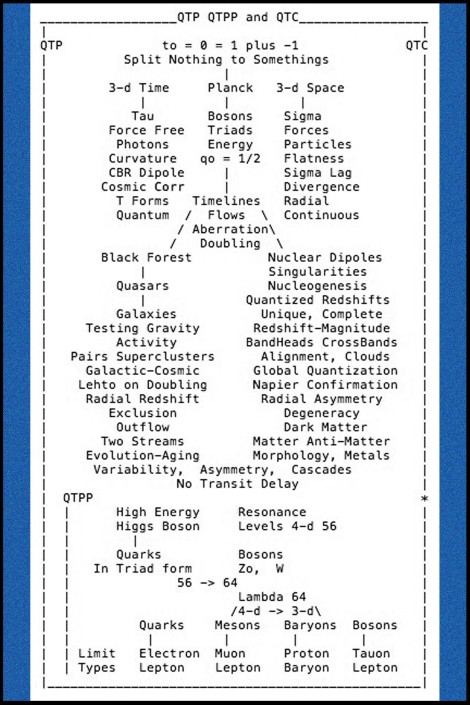Topic020: Baryons, The Electron and Particle Class relationships,
Bill Tifft, 5/22/16

Top section of table 7 in book chapter 4

Book figure 4.5 and first section of table 4 in chapter 4
Before plunging into the details of the nature of fundamental particles and forces, it is important to recognize that something simpler had to come before to assemble space and the complexities of the multitude of particles up to and including galaxies. In QTC the universe begins with the birth of time. An early stage of temporal interaction had to generate timelines, and Sigma space with its forces, as classes of matter developed. Although I will defer discussing that early hypothetical (but consistent) stage to Chapter 8 of my book and later Topics, it is useful to reflect on what QCT has demonstrated. (For book information or acquisition see Post001 and Post002.) A terminal figure following this Topic scans through the evidence that the entire universe is a vast quantum structure. By reflecting upon what we have seen perhaps we can better appreciate the incredible picture in QTPP upon which it is built. If you have read my book or just the Topics to date, the line by line word or statements in the table should bring to mind the fascinating quantum evidence of the nature of our universe. After mid page there are items in the book but not yet in previous topics preceding particle discussion. If the terms and phrases stimulate and excite your mind with new ideas, then you will be prepared for even more in QTPP and the return to QTC to follow. It took almost 50 years to understand and develop what that table lists.
As acknowledged in my book, Ari Lehto, a physicist in Finland, suggested using period doubling, beginning at the Planck level, to define values for redshifts and particle properties. His initial work defined energy levels (as I now define them as composite doubling levels in 3 or 4 dimensions) of the electron as 227/3 = Gamma 75.67 and the Proton as 192/3 = Pi 64.00. By modeling the magnetic moments of the pair, as described in book section 4.2.4, Lehto demonstrated the radial vs azimuthal energy level distinction, which splits energy doubling patterns into the Gamma and Pi patterns. Lehto recognized the three parameter (dimensional) character of particle models but association with time in 4-d is primarily related to my work in cosmology. My particle work began later. Beyond initial background our work is independent.
The electron and proton are in fact closely related aside from the fact that a neutron is a combination of them. The electron anti-electron energy level is one doubling level above the electron, 224/3 = Gamma 74.67 = (128 64 32)/3 when written in a pure doubling form. The proton is 192/3 = Pi 64.00 = (64 64 64)/3. Both have the same number of dimensional doubling with one doubling switch between the ends. 224 – 192 = 32, a doubling number itself, and a product of 4 times 8, which are a square and cube of 2. 64 is a square of 8 and a cube of 4. One can see how transformations between doubling patterns can interrelate particles and be consistent with 3-d Keplerian dynamics (based upon inverse square divergence of force in 3-d space). Squares and cubes combine beautifully in dynamics and substructures. It seems clear why matter exists as particles closely associated with level 64. However, development of doubling patterns within Tau and Sigma are not necessarily directly related. It seems likely that matter, or something equivalent, formed early in the history of timeline development. In that sense QTC and classical cosmology have some common ground. Discussion of electrons and other (muon and tauon) leptons is deferred to a later topic.
Turning to 4-d structures there is again a close interrelation. The Lambda baryon can be represented in 4-d as (64 64 64 63)/4 = 63.75, one doubling from 64 64 64 64 which is denoted as the 4-d Hadron base (Hadron is the name for particles constructed from quarks, the bosons, mesons and baryons). 64 64 64 is the 3-d Hadron base. The top leading figure for this topic, part of Table 7 in book chapter 4, summarizes basic doubling configurations defined and used in discussions of particle energy levels. Subtracting eights from the four 64s yields a pattern designated as the `4-d Higgs neutral base’ 56 56 56 56, which sums to 224, identical to an electron anti-electron pair in a different configuration. 56 is also 7 times 8 where 7 = 1 2 4, which is the base quantum energy and structural unit designated as the `triad’. The lower left leading figure repeats book figure 4.5, from Topic019, showing the baryon energy pattern. All baryons either match the (64 64 64)/3 = 64.00 3-d Hadron base (one Gamma, one Pi form), or differ by only one doubling. The Cascade = Gamma(64 64 65)/3 = 64.33, the Sigma = Pi(63 64 64)/3 = 63.67 and, as noted above, the Lambda = Pi(64 64 64 63)/4 = 63.75. The Lambda is further discussed in the topic related to mesons. It marks a transition point from 4-d to 3-d between baryons and mesons. Baryons form a set of close 3-d energy levels around 64.00 with a link to mesons. The upper part of Table 4 in book chapter 4 is shown to the right on a second line of leading figures. It shows baryon rest mass energies, fit levels, transmission matches and fit deviations in Mev. Fits are nearly all within 1 percent of rest masses. This is also the case for leptons, mesons, and some higher energy bosons including Higgs. Such a fit to the entire set of the `stable’ particles is incredibly unlikely by accident, with more to come along with other cosmological findings.

Quantum Temporal Physics, Particle Physics and Cosmology
| ← Topic019 | Topic021 → |


Reblogged this on Time in Cosmology.
LikeLike